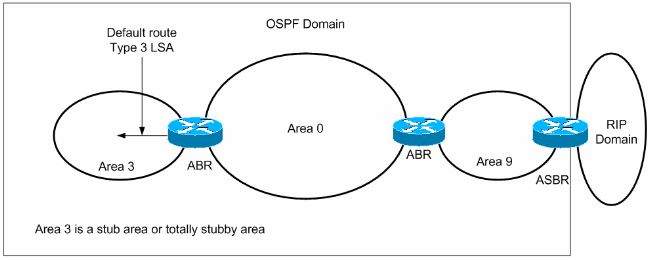- Cisco Community
- Technology and Support
- Networking
- Switching
- OSPF Stub Qeustion ???
- Subscribe to RSS Feed
- Mark Topic as New
- Mark Topic as Read
- Float this Topic for Current User
- Bookmark
- Subscribe
- Mute
- Printer Friendly Page
- Mark as New
- Bookmark
- Subscribe
- Mute
- Subscribe to RSS Feed
- Permalink
- Report Inappropriate Content
03-08-2016 05:31 PM - edited 03-08-2019 04:53 AM
Hello,
My teacher gave us a Homework packet and this one question doesn't make sense to me.
The graph bellow says any type of stub will inject a default route to reach another area depending on what lsa is replacing the old lsa.
Question 18 asks when the default-information originate command is not entered what stub will cause a router not to receive a default route from a abr or asbr? wont a abr or asbr cause a 0.0.0.0 0.0.0.0 route becuse of a stub configuration.


Solved! Go to Solution.
- Labels:
-
Other Switching
Accepted Solutions
- Mark as New
- Bookmark
- Subscribe
- Mute
- Subscribe to RSS Feed
- Permalink
- Report Inappropriate Content
03-08-2016 08:52 PM
Joshua,
I guess what the Question 18 asks about is: "Is there a non-default OSPF area type that does not receive default route by default from its ABR?" You surely know that both stuby and totally stubby areas receive a default route automatically from their ABRs to replace the suppressed external or even inter-area routes.
However, this is not entirely true with NSSA. An NSSA area does not automatically inject a default route from the ABR unless you have configured area area-id nssa default-information-originate on its ABR. This is because in a stubby area that yet has the privilege of injecting its own external routes, there is no sensible default behavior - perhaps the only external routes the area should be allowed to reach are those injected through its own ASBR, and other external routes that are in the backbone or beyond it should not be covered by a default route because then, they would be reachable as well. So in short, if you configure a NSSA area, it won't receive a default route automatically - you have to request it.
In the NSSA Totally Stubby, the default route is injected automatically again, as here, it replaces the connectivity to other areas.
Best regards,
Peter
- Mark as New
- Bookmark
- Subscribe
- Mute
- Subscribe to RSS Feed
- Permalink
- Report Inappropriate Content
03-08-2016 05:44 PM
Please go through the following link:-
http://www.cisco.com/c/en/us/support/docs/ip/open-shortest-path-first-ospf/13692-21.html
Stub and Totally Stub Areas
In stub and totally stub areas, the ABR to the stub area generates a summary LSA with the link-state ID 0.0.0.0. This is true even if the ABR doesn't have a default route of its own. In this case, you don't need to use the default-information originate command.
As previously discussed, external routes are not propagated inside the stub areas and even inter-area routes (summary routes) are not propagated inside the totally stubby areas. The routers inside these areas use the default route generated by the ABR to reach destinations outside of the area.
For a Sample Configuration of how OSPF injects a default route into a stub or totally stub area, refer to How OSPF Injects a Default Route into a Stub or Totally Stub Area.
HTH
Regards
Inayath
- Mark as New
- Bookmark
- Subscribe
- Mute
- Subscribe to RSS Feed
- Permalink
- Report Inappropriate Content
03-08-2016 08:52 PM
Joshua,
I guess what the Question 18 asks about is: "Is there a non-default OSPF area type that does not receive default route by default from its ABR?" You surely know that both stuby and totally stubby areas receive a default route automatically from their ABRs to replace the suppressed external or even inter-area routes.
However, this is not entirely true with NSSA. An NSSA area does not automatically inject a default route from the ABR unless you have configured area area-id nssa default-information-originate on its ABR. This is because in a stubby area that yet has the privilege of injecting its own external routes, there is no sensible default behavior - perhaps the only external routes the area should be allowed to reach are those injected through its own ASBR, and other external routes that are in the backbone or beyond it should not be covered by a default route because then, they would be reachable as well. So in short, if you configure a NSSA area, it won't receive a default route automatically - you have to request it.
In the NSSA Totally Stubby, the default route is injected automatically again, as here, it replaces the connectivity to other areas.
Best regards,
Peter
Discover and save your favorite ideas. Come back to expert answers, step-by-step guides, recent topics, and more.
New here? Get started with these tips. How to use Community New member guide


